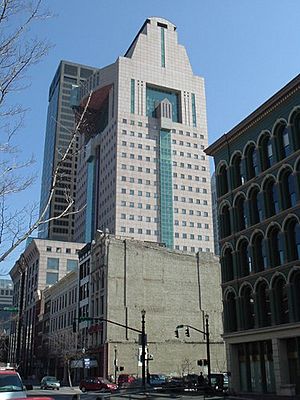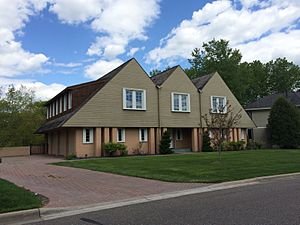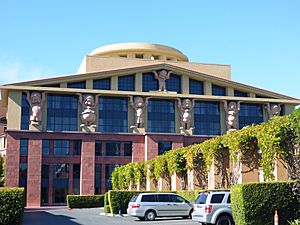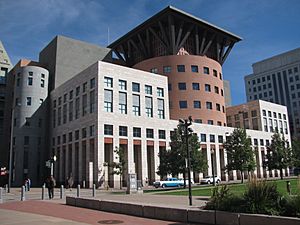Michael Graves facts for kids
Quick facts for kids
Michael Graves
|
|
|---|---|

Graves in 1987
|
|
| Born | July 9, 1934 Indianapolis, Indiana, U.S.
|
| Died | March 12, 2015 (aged 80) Princeton, New Jersey, U.S.
|
| Occupation | Architect |
| Awards | National Medal of Arts (1999) AIA Gold Medal (2001) Driehaus Architecture Prize (2012) |
| Buildings | Portland Building (Oregon); Humana Building (Kentucky); Denver Public Library (Colorado); Walt Disney World Swan and Dolphin Resorts (Florida) |
Michael Graves (born 1934, died 2015) was a famous American architect and designer. He also taught at Princeton University for almost 40 years.
Graves designed many different types of buildings around the world. These included the Ministry of Culture in The Hague and a post office in Celebration, Florida. He also designed several buildings for Disney. Graves even designed the scaffolding for the Washington Monument restoration in 2000.
He was a big influence on architectural styles like Postmodernism. His famous buildings in this style include the Portland Building in Oregon and the Humana Building in Kentucky.
For his amazing work, Graves received many top awards. These included the AIA Gold Medal in 2001. He also won the National Medal of Arts in 1999.
Besides buildings, Graves became very well known for designing everyday products. He created items for companies like Alessi in Italy and Target in the United States. The New York Times newspaper called him "one of the most prominent and prolific American architects of the latter 20th century." He designed over 350 buildings and was also famous for his teakettles and pepper mills.
Contents
Early Life and Education
Michael Graves was born on July 9, 1934, in Indianapolis, Indiana. He grew up in the suburbs of the city. His mother suggested he become an engineer or an architect.
Graves finished high school in 1950. He then earned a bachelor's degree in architecture from the University of Cincinnati in 1958. He also got a master's degree in architecture from Harvard University in 1959.
After college, Graves worked for a year with designer George Nelson. In 1960, Graves won the Prix de Rome award. This allowed him to spend two years studying in Italy. He said this time in Rome "transformed" him. He learned new ways to see and understand buildings and landscapes.
His Career in Architecture

Graves started teaching architecture at Princeton University in 1962. He taught there for almost 40 years. In 1964, he opened his own architecture firm in Princeton, New Jersey.
Over nearly 50 years, Graves and his firm designed more than 350 buildings. These included homes, university buildings, hotels, hospitals, and museums. They also designed about 2,000 household products.
Teaching Architecture
Graves taught at Princeton University for 39 years. He retired in 2001. Even though he taught many architecture students, the university did not allow its professors to design buildings on campus. So, Graves never designed a building for Princeton. Later in his life, he helped start a new college named after him at Kean University.
Designing Buildings
In his early career, Graves designed home renovations in Princeton. He founded Michael Graves & Associate in 1964. His firm had offices in Princeton and New York City. His home in Princeton was also his design studio and a place to show his many collected items. It was nicknamed "The Warehouse."
Modernist Style
In the late 1960s and early 1970s, Graves designed modernist homes. Examples include the Hanselman House (1967). Graves also became part of a group called the New York Five. This group of architects used a pure form of modernism. Their designs had clean lines and very little decoration. They were known as the "Whites" because their buildings were often white.
Postmodernist Style
In the late 1970s, Graves changed his style. He moved towards Postmodernism and New Urbanism. His new designs often had Cubist-inspired shapes and bright colors. Postmodernism allowed him to add humor and a more human touch to his buildings. His designs became known for their "playful style" and "colorful facades." This was a big change from his earlier work. The Plocek Residence (1977) was one of his first designs in this new style.
Some of Graves' most famous buildings were designed in the early 1980s. One of these is the Portland Building. This 15-story building opened in 1982 in Portland, Oregon. It was his first major public project. The building has decorated sides and colorful, oversized columns. It is seen as a very important example of Postmodern architecture. It became an icon for the city of Portland. The Portland Building was added to the National Register of Historic Places in 2011.
Because of the Portland Building, Graves received many other big projects. These included the Humana Building (1982) in Kentucky. Some critics, like Paul Goldberger, think the Humana Building is one of Graves' best designs. TIME magazine called it one of the best buildings of the 1980s. The San Juan Capistrano Library (1982) in California showed his take on the Mission Revival style.
Graves and his firm also designed several buildings for The Walt Disney Company. These were all in the postmodern style. They include the Team Disney headquarters in Burbank, California. He also designed the Dolphin (1987) and Swan (1988) resorts at Walt Disney World in Florida. Another Disney project was Disney's Hotel New York (1989) in Disneyland Paris. Disney called Graves' designs "entertainment architecture."
Other important buildings by Graves in the 1990s include an expansion of the Denver Public Library (1990). He also worked on the renovation of the Detroit Institute of Arts (1990).
Postmodern architecture did not stay popular forever. Some of Graves' ideas were even rejected. For example, his design for an expansion of the Whitney Museum in New York City was never built.
Graves continued to work as an architect until he died in 2015. Later projects include the O'Reilly Theater (1996) in Pittsburgh. He also designed the NCAA Hall of Champions in Indianapolis. International projects included the Sheraton Miramar Hotel (1997) in El Gouna, Egypt. One of his last projects was the Louwman Museum (2010) in The Hague, Netherlands.
Designing Products and Furniture
Michael Graves also became a famous designer of everyday products. His unique style was well known in the 1980s and 1990s. He designed household items for big companies like Target and Alessi. His design group created over 2,000 products.
In the early 1980s, Graves joined the Memphis Group. This was a postmodern design group in Milan, Italy. He started designing furniture and home accessories. His "Plaza" dressing table is a notable example.
Around the same time, Graves began working with Alessi. This company makes high-end kitchenware in Italy. In 1982, Graves designed a fancy silver tea service for Alessi. This was a big moment in his career. He became known for more than just architecture.
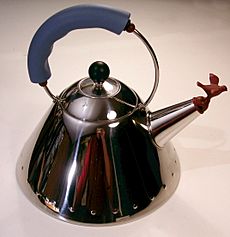
Alessi then asked Graves to design a more affordable kettle. In 1985, Graves designed his famous stainless-steel teakettle (9093 stovetop kettle). This kettle had a red, bird-shaped whistle. It was the company's best-selling product for 15 years. In 2015, for its 30th anniversary, Graves designed a special version with a dragon whistle.
In 1997, Graves designed the scaffolding for the Washington Monument restoration. There, he met a Target executive named Ron Johnson. This meeting led to a partnership between Graves and Target that lasted until 2012. Graves started by designing a few products for Target stores. His collection of housewares began selling in January 1999.
In 1998, Target asked Graves to design a model home to show off his new housewares. Graves designed "Cedar Gables," a modern house in Minnetonka, Minnesota. It included custom furniture, lighting, and other unique items. This was one of only three homes he designed and furnished completely. By 2009, Graves felt the house "doesn't have a wow factor."
When his partnership with Target ended in 2012, Graves had designed over 500 items for the retailer. He then started designing products for J.C. Penney. Graves also created items for other companies. For example, in the 1990s, he designed the Mickey Mouse Gourmet Collection for Disney.
In 2013, Graves designed a teapot for JCPenney. It became known as the “Hitler teapot” because some people thought it looked like Adolf Hitler. This caused some controversy.
Graves also worked on many other design projects. He designed sets and costumes for the Joffrey Ballet. He created jewelry, vinyl flooring, and rugs. In 1994, Graves opened a small store in Princeton, New Jersey. Shoppers could buy his designs and art reproductions there.
Later Years and Legacy
Graves retired from teaching at Princeton University in 2001. But he stayed active in his architecture and design firm. In the last ten years of his life, he also became a champion for people with disabilities.
In 2003, Graves became paralyzed from the waist down due to an infection. Using a wheelchair made him more aware of the needs of disabled people. After weeks in the hospital, Graves changed his home to be more accessible. He then went back to his design work.
He designed wheelchairs, hospital furniture, and housing for disabled veterans. Graves became a "reluctant health expert." He was also known worldwide for supporting accessible design. In 2013, President Barack Obama appointed Graves to the United States Access Board. This agency helps people with disabilities with accessibility issues.
In 2014, Graves helped start the Michael Graves College at Kean University. This college includes a School of Public Architecture. Kean University now owns Graves' former home and studio in Princeton. They plan to use it as an educational research center.
Graves died at his home in Princeton, New Jersey, on March 12, 2015. He was 80 years old.
Graves believed in a "humanistic approach to architecture." He greatly influenced architecture in the late 20th century. He was one of the most active and famous American architects from the mid-1960s onward. His designs influenced Postmodern, New Classical, and New Urbanism styles.
The Cooper Hewitt, Smithsonian Design Museum honored Graves with a lifetime achievement award. They said he "broadened the role of the architect in society." He also made people more interested in good design for everyday life. Graves and his firm designed over 2,000 consumer products. He was especially famous for his household items. His most well-known product is the iconic kettle he designed for Alessi in 1985. As an advocate for the disabled, Graves used his skills to "improve healthcare experience for patients."
Awards and Honors
- In 1979, Graves became a Fellow of the American Institute of Architects.
- He was a trustee of the American Academy in Rome from 1980 to 1984.
- In 1986, Graves received the Golden Plate Award from the American Academy of Achievement.
- He was awarded the American Prize for Architecture in 1994.
- President Bill Clinton gave Graves the National Medal of Arts in 1999.
- Graves was named GQ's Man of the Year in 1999.
- He received the AIA Gold Medal in 2001, the highest award from the American Institute of Architects.
- Graves was the first person to receive the Michael Graves Lifetime Achievement Award from the AIA-NJ.
- He received honorary degrees from the University of Miami in 2001.
- In 2002, the Indiana Historical Society named Graves an Indiana Living Legend.
- In 2009, Graves was named a Design Futures Council Senior Fellow.
- He was inducted into the New Jersey Hall of Fame in 2010.
- In 2010, he was recognized as one of the top 25 "most influential people in healthcare design."
- Graves won the Driehaus Architecture Prize in 2012.
- He received an honorary degree from Emory University in 2013.
- From 2014 to 2015, an exhibition called "Michael Graves: Past as Prologue" was held. It celebrated 50 years of his firm.
- In 2014, the Architectural League of New York held a symposium in his honor.
- In 2015, the Cooper Hewitt Smithsonian Design Museum gave Graves a National Design Award for Lifetime Achievement after his death.
Works
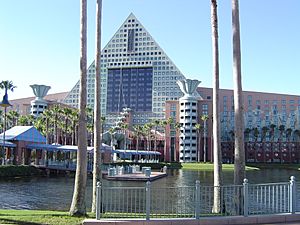
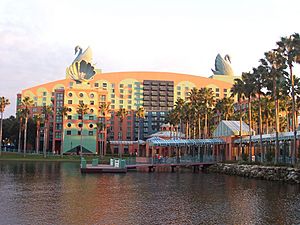
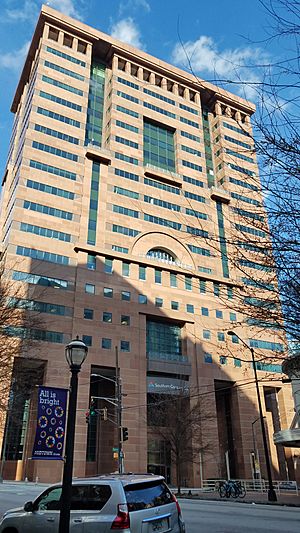
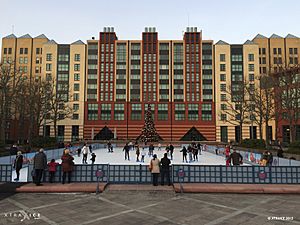
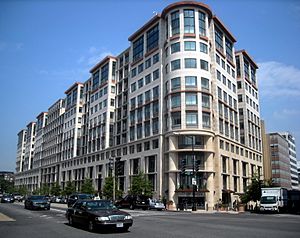
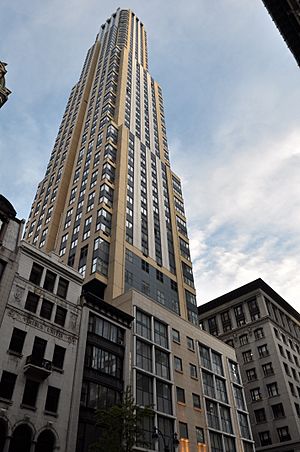

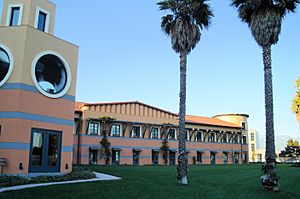

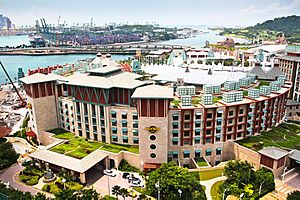
- Hanselmann House, Fort Wayne, Indiana, 1968
- Snyderman House, Fort Wayne, Indiana, 1972
- Plocek Residence, Warren, New Jersey, 1977 (Graves' first postmodern design)
- Portland Building, Portland, Oregon, 1982
- Humana Building, Louisville, Kentucky, 1982
- Newark Museum expansion, Newark, New Jersey, 1982
- San Juan Capistrano Library, San Juan Capistrano, California, 1982
- Team Disney headquarters building, Burbank, California, 1986
- Graves Residence ("The Warehouse"), Princeton, New Jersey, 1986
- Dolphin Resort, Walt Disney World, Orlando, Florida, 1987
- Swan Resort, Walt Disney World, Orlando, Florida, 1987
- Disney's Hotel New York, Euro Disney Resort (now Disneyland Paris), Marne-la-Vallée, France, 1989
- Ten Peachtree Place, Atlanta, Georgia, 1989
- Denver Public Library, Denver, Colorado, 1990
- Detroit Institute of Arts master plan, Detroit, Michigan, 1990
- Kavli Institute for Theoretical Physics, University of California, Santa Barbara, California, 1990
- Michael C. Carlos Museum, Emory University, Atlanta, Georgia, 1993
- Ministry of Health, Welfare and Sport, The Hague, Netherlands, 1993
- U.S. Post Office, Celebration, Florida, 1993
- O'Reilly Theater, Pittsburgh, Pennsylvania, 1996
- Indianapolis Art Center, Indianapolis, Indiana, 1996
- NCAA Hall of Champions and headquarters, Indianapolis, Indiana, 1997
- Cedar Gables House, Minneapolis, Minnesota, 1998
- Washington Monument scaffolding, Washington, D.C., 1999
- 425 Fifth Avenue, New York, New York, 2000
- Louwman Museum (National Automobile Museum), The Hague, Netherlands, 2010
- Resorts World at Sentosa, Singapore, 2010
See also
 In Spanish: Michael Graves para niños
In Spanish: Michael Graves para niños


